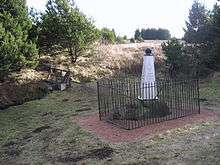Alexander Peden
Alexander Peden (1626 – 26 January 1686), also known as "Prophet Peden", was one of the leading figures in the Covenanter movement in Scotland.
Alexander Peden | |
|---|---|
.jpg) Peden's blue plaque at Mistyburn, Antrim | |
| Personal | |
| Religion | Christianity |
| School | Presbyterianism |
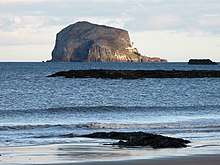
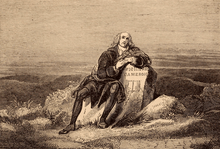
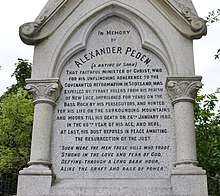
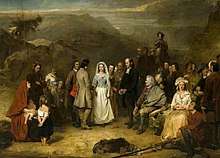
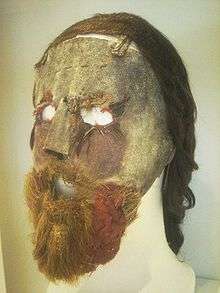
Life
Peden was born at Auchincloich Farm near Sorn, Ayrshire, about 1626, and was educated at the University of Glasgow.[4][5] He was a teacher at Tarbolton and then ordained minister of New Luce in Galloway in 1660.[6]
His name can also be spelled Peathine or Pethein.[7] He was born in Auchencloich in the parish of Sorn about 1626.[8] He was the son of a small proprietor. He was possibly the Alexander Peden who was the restored heir of his grandfather in Hillhead of Sorn, 16 March 1648, and on the same day heir of Auchinlonfuird. Of his early training there is no clear record, but he may have attended the parish school of Mauchline, and was a student at Glasgow University from 1643 to 1648. For a time he acted as schoolmaster, precentor, and session-clerk at Tarbolton, and, according to Wodrow, was employed in a similar capacity at Fenwick. As he was about to receive license from the Presbytery of Ayr, an accusation of immorality was raised against him, but was found to be false. In 1659 he was ordained to this charge, and was deprived by Act of Parliament 11 June, and Decreet of Privy Council 1 October 1662. When he preached his farewell sermon he is said to have occupied the pulpit till nightfall, and on leaving it, to have knocked three times on the door with his Bible, saying, "I arrest thee in my Master's name, that none enter thee but such as come by the door, as I have done." Following his ejectment Peden became perhaps the most celebrated field preacher of his time. He wandered all over the South of Scotland, obtaining by his figurative and oracular style of address and his supposed prophetic gifts an extraordinary influence over the people, which was further increased by his hardships, perils, and numerous hairbreadth escapes.
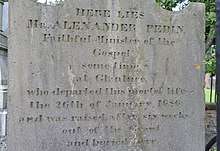
On 25 January 1666 he was denounced as a rebel, and was excepted from the pardon after the Pentland Rising. He fled to Ireland in 1670, but having returned in 1673, was apprehended at Knockdow, in Ballantrae Parish, and sent to the Bass Rock. He was confined there from 26 June 1673 to 9 October 1677, when he was removed to the Edinburgh Tolbooth, where he remained till December 1678. A petition for liberation was refused, and he was sentenced instead to perpetual banishment. The captain of the ship which was chartered to convey Peden and his companions to the Virginia plantations, discovering them to be persons banished for their religious opinions, and not convicts, declined to take them aboard, and they were set at liberty. From London, Peden found his way back to Scotland, and again to Ireland. He returned to Ayrshire in 1685, and preached his last sermon at Colinswood, on the Water of Ayr. His privations and anxieties had gradually undermined his health, and, resolving to spend his last days in his native district, he found shelter in a cave on the banks of the Ayr, near Sorn. Having a presentiment that he had not many hours to live, he left the cave one evening, and went to his brother's house at Sorn, where he died, 28 January 1686. He was buried in the Boswell aisle of Auchinleck Church. Forty days after, a troop of dragoons lifted his corpse, carried it two miles to Cumnock gallows, and were about to hang it up in chains. Finding this impossible, they buried it at the gallows foot. After the Revolution the inhabitants of the parish of Cumnock, in token of their esteem for Peden, abandoned their ancient burial-place, and formed a new one round the gallows hill. He was the most eminent and revered of all the Scottish covenanting preachers, and his influence upon the mass of the people was so great that they gave him the name of "The Prophet," and were accustomed to regard him as almost possessed of the prophetic afflatus.[7][9]
After the restoration of Charles II, Peden had to leave his parish under Middleton's Ejectment Act in 1663. On 16 August 1667 he was declared a fugitive.[10]
For ten years he wandered far and wide, bringing comfort and succour to his co-religionists, and often very narrowly escaping capture, spending some of his time in Ireland.[6] To hide his identity, Peden took to wearing a cloth mask and wig, which are now on display in Edinburgh's Museum of Scotland.
In June 1673, while holding a conventicle at Knockdow near Ballantrae, Ayrshire, he was captured by Major William Cockburn, and condemned by the Privy Council to four years and three months' imprisonment on the Bass Rock and a further fifteen months in the Edinburgh Tolbooth.[6]
In December 1678 he, along with 60 others, was sentenced to banishment to the American plantations.[6] They were transported by ship to London, where they were to be transferred to an American ship. The American captain, however, on hearing the reason for their banishment, released them. Peden made his way north again and divided the remaining years of his life between his own country and the north of Ireland. His last days were spent in a cave on the River Lugar in the parish of Sorn, near his birthplace and his brother's farm in Auchinleck, and there he died in 1686, worn out by hardship and privation.[6]
He was buried in Auchinleck churchyard. Six weeks later his body was exhumed by troops from Sorn Castle, who planned to hang his corpse from the gallows in Cumnock. However William Crichton, 2nd Earl of Dumfries objected to the hanging, so the troops buried the corpse at the foot of the gallows. In 1891 a monument was erected to mark the spot.
Prophet Peden receives a good deal of attention in Jack Deere's book "Surprised by the Voice of God" which records prophetic and other charismatic gifts practiced by historical reformed figures. In 1682, Peden performed the wedding ceremony of John Brown and Isabel Weir. He told Isabel after the ceremony, "You have a good man to be your husband, but you will not enjoy him long; prize his company, and keep linen by you to be his winding sheet, for you will need it when ye are not looking for it, and it will be a bloody one".
On the night of 30 April 1685, troops commanded by Captain John Graham of Claverhouse shot John Brown for Brown's refusal to take the 1684 Oath of Abjuration[11] or to swear not to rise in arms against the king. This Oath required the person taking it to "abhor, renounce and disown in the presence of Almighty God, the pretended Declaration of War [Renwick's "Vindication"] lately affixed at several parish churches, in so far as it declares war against his sacred Majesty, and asserts that it is lawful to kill such as serve his Majesty in Church, State, Army or Country, or such as act against the authors of the pretended Declaration now shown to me." This oath did not require one to proclaim the king, rather than Christ, as the head of the church. However, its inclusion of a reference to his Magesty's servants in the Church was obviously Erastian. It would have been understood by a Covenanter to be a promise not to resist the King's claimed supremacy in all causes, ecclesiastical as well as civil, as claimed in the 1682 Abjuration Act. Further, weapons and writings considered treasonous by the authorities were found in Brown's house.
The story that Claverhouse subsequently taunted Brown's wife about his death appeared some years after his death, written by men who were not present at the time.[12] Peden was 11 miles away. He prayed with the family of John Muirhead in his home, "Lord, when wilt Thou avenge Brown's blood? O, let Brown's blood be precious in Thy sight." Peden told them of his vision of Brown's wife weeping over his corpse and of Claverhouse killing John Brown. Isabel Brown buried her husband in the sheet she had saved. Peden was well known for God's spectacular answers to his prayers.
Alexander Peden Stone
The Alexander Peden Stone was where Rev. Alexander Peden and others were said to have preached to Covenanters. The monument was erected around 1866 and is maintained by a local Covenanters' committee. The stone on which the monument is mounted would have been used as the plinth by preachers.
Bibliography
- The Lord's Trumpet sounding an Alarm against Scotland by Warning of a Bloody Sword; being the substance of a Preface and two Prophetical Sermons preached at Glenluce, Anno 1682, by that great Scottish Prophet, Mr. Alexander Peden, late Minister of the Gospel at New Glenluce in Galloway,’ was published at Glasgow in 1739, and reprinted in 1779.
- Letters to Mr Patrick Simson (and others)
- The Life and Prophecies of Alexander Peden by Patrick Walker
- Histories of Kirkton and Wodrow
- Howie's Scottish Worthies
- New Statistical Account of Scotland
- Hew Scott's Fasti Eccles. Scot. i. 168
- Scott's Old Mortality, note 18
- Watson's Life and Times of Peden, Glasgow, 1881.
- Reid's Ireland, ii.
- Six Saints of the Covenant, ed. by D. Hay Fleming pp. 45–178[13]
- Johnston's Alexander Peden, the Prophet of the Covenant, and Treasury of the Scottish Covenant
- Todd's Homes, Haunts, and Battlefields of the Covenanters
- Jean L. Watson's Life and Times of Peden
- Hewat's Peden the Prophet
- Carslaw's Exiles of the Covenant
- Tombstone
- Dictionary of National Biography[4]
- Biographia Presbyteriana[14]
See also
- Peden's Cave, Craigie
- Peden's Cave (Auchinbay)
References
- Dickson, John (1899). Emeralds chased in Gold; or, the Islands of the Forth: their story, ancient and modern. [With illustrations.]. Edinburgh and London: Oliphant, Anderson & Ferrier. p. 225. Retrieved 3 March 2019.

- Menteath, A. Stuart, Mrs (1852). Lays of the kirk and covenant. New York : R. Carter & Brothers. pp. 122–133. Retrieved 16 April 2019.
- Jardine, Mark. "Alexander Peden: Prophecy, Ploughmen and Preaching in 1682". Jardine's Book of Martyrs. Retrieved 12 April 2019.
- Henderson, Thomas Finlayson (1895). "Peden, Alexander". In Lee, Sidney (ed.). Dictionary of National Biography. 44. London: Smith, Elder & Co. pp. 205–206.

- Morton, Alexander S. (1914). Galloway and the Covenanters; or, The struggle for religious liberty in the south-west of Scotland. Paisley : A. Gardner. pp. 319-328. Retrieved 12 April 2019.
- Chisholm, Hugh, ed. (1911). "Peden, Alexander". Encyclopædia Britannica. 21 (11th ed.). Cambridge University Press. p. 37.

- Scott, Hew (1917). Fasti ecclesiae scoticanae; the succession of ministers in the Church of Scotland from the reformation. 2. Edinburgh: Oliver and Boyd. pp. 345–346. Retrieved 12 April 2019.

- M'Crie, Thomas, D.D. the younger (1847). The Bass rock: Its civil and ecclesiastic history. Edinburgh: J. Greig & Son. pp. 24–57. Retrieved 22 December 2018.

- Kerr, Robert P. (1905). The blue flag; or, The Covenanters who contended for "Christ's crown and covenant". Richmond : Presbyterian Committee of Publication. pp. 108–115. Retrieved 12 April 2019.
- The records of the proceedings of the Justiciary court, Edinburgh, 1661-1678. 1. Edinburgh, Printed at the University Press by T. and A. Constable for the Scottish History Society. 1905. p. 241. Retrieved 12 April 2019.
- "abjurationOath".
- Tayler, Alistair and Henrietta. John Graham of Claverhouse. London: Duckworth, 1939.
- Walker, Patrick; Fleming, David Hay (1901). Six saints of the Covenant : Peden: Semple: Welwood: Cameron: Cargill: Smith. 1. London : Hodder and Stoughton. pp. 45–178. Retrieved 15 April 2019.
- Walker, Patrick; Shields, Alexander; Stevenson, John (1827). Biographia Presbyteriana. 1. Edinburgh: D. Speare. Retrieved 18 April 2019.CS1 maint: ref=harv (link)
External links
![]()
- Peden's Pulpit video
- Video footage of Alexander Peden's Memorial.
- Dunton Cove, Covenanter's Hiding Place.
- Peden's Cave video footage
![]()
